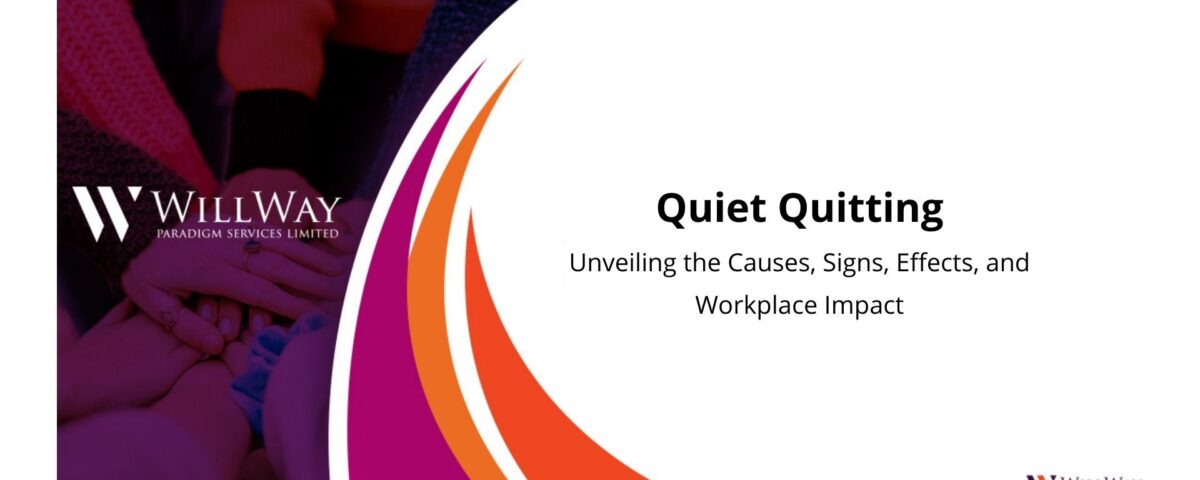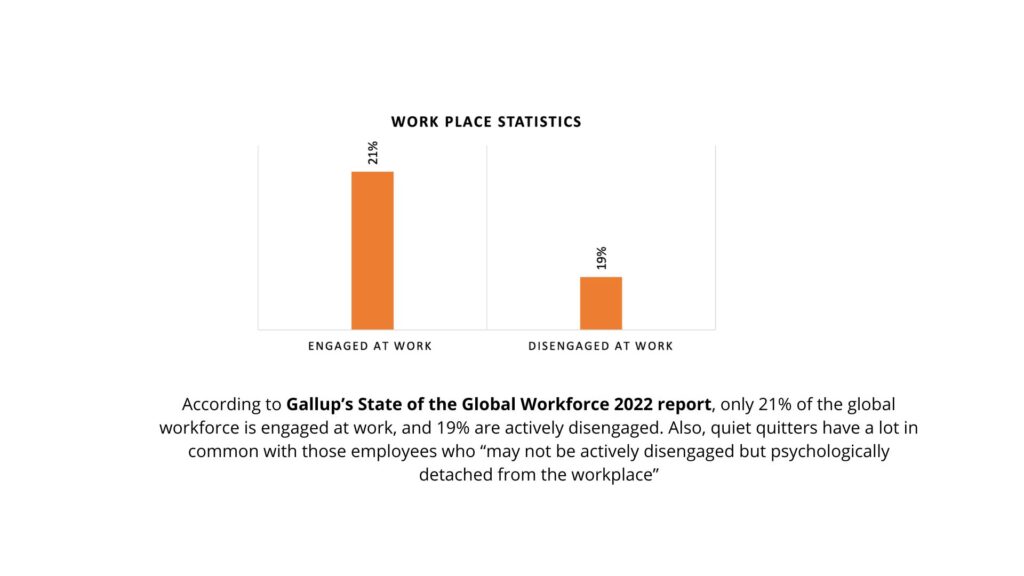
In today’s fast-paced and competitive work environment, employees’ dissatisfaction and disengagement can often lead to a phenomenon called “quiet quitting.” Unlike traditional resignation, quiet quitting refers to a situation where employees mentally check out from their jobs while remaining physically present. This article aims to explore the causes and signs of quiet quitting, shed light on its effects on both individuals and organizations and analyze how it impacts the workplace. By understanding this silent epidemic, employers can take proactive steps to address the underlying issues and foster a healthier work environment.
Causes of Quiet Quitting

According to Gallup’s State of the Global Workforce 2022 report, only 21% of the global workforce is engaged at work, and 19% are actively disengaged. Also, quiet quitters have a lot in common with those employees who “may not be actively disengaged but psychologically detached from the workplace”.
Several underlying factors contribute to the emergence of quiet quitting among employees. They include the following:
- Lack of Meaningful Work: One primary cause is the lack of meaningful work. When individuals find their job tasks monotonous, unchallenging, or disconnected from their values and aspirations, they are more likely to disengage mentally while maintaining their physical presence.
- Poor leadership and management practices: This can lead to a sense of disempowerment and detachment among employees. When supervisors fail to provide clear expectations, recognition, and opportunities for growth, employees may lose motivation, resulting in quiet quitting.
- Toxic work environment: A work environment characterized by conflicts, bullying, or favouritism can push employees to withdraw mentally. Feeling undervalued, unsupported, or underappreciated can erode their commitment and enthusiasm.
What are the signs of Quiet Quitting
Identifying signs of quiet quitting is crucial for both employees and employers. While it may be challenging to detect, some common indicators include decreased productivity, lack of initiative, and diminished creativity. When people stop sharing their opinion on any issue and just ‘go with the flow’ is a classic sign that they’ve mentally disengaged. Employees who quietly quit may also exhibit a decline in their social interactions, become disengaged during meetings, or appear apathetic towards organizational goals. Everything is just a big Meh!
Furthermore, absenteeism or an increase in sick leaves without valid reasons might suggest an employee’s disengagement. They may show a lack of interest in personal development opportunities, refuse to take on new challenges, or display signs of disorganization and neglect in their work.
Effects of Quiet Quitting
The impact of quiet quitting extends beyond the individual employee to the entire organization. Disengaged employees not only fail to contribute fully but can also become a source of negativity, affecting team morale and productivity. Quiet quitting can also foster a culture of mediocrity, as other employees may perceive the lack of consequences for disengaged colleagues.
The effects of quiet quitting can ripple into customer interactions, leading to a decline in service quality, customer satisfaction, and loyalty. Disengaged employees are less likely to go the extra mile for customers, resulting in a poor brand image and potential business losses.
Workplace Impact and Mitigation Strategies
The impact of quiet quitting on the workplace necessitates proactive measures to foster employee engagement and well-being.
- Create Positive work culture: Organizations should prioritize creating a positive work culture that promotes genuine open communication, trust, and respect. Encouraging employee feedback, recognizing achievements, and providing opportunities for skill development can significantly contribute to reducing quiet quitting.
- Effective leadership: Furthermore, leaders and managers must be trained in effective leadership practices. Managers and supervisors must learn how to have conversations to help employees reduce disengagement. By setting clear expectations, providing regular feedback, and supporting their teams’ growth, supervisors can mitigate the risk of employees quietly quitting.
- Employee surveys: Employee engagement surveys can serve as valuable tools to identify the prevalence of quiet quitting and uncover underlying issues. Organizations can use these insights to implement targeted interventions, such as job redesign, flexible work arrangements, or mentorship programs. The key here is to ensure that actionable items are created of the employee feedback.
- Doing meaningful work: employers should provide employees with opportunities to align their tasks with their interests and strengths. Overall goals and strategy should be properly communicated and drilled down to individual contributions. Job rotation, cross-functional projects, and autonomy in decision-making can help increase job satisfaction and reduce disengagement.
It’s common for employers and business owners to see employees from the spectrum of just ‘talent’ instead of seeing them as people. This is a common flaw and leads to a wide range of problems like quiet-quitting. To understand employees organizations must first see them as human beings, with varying backgrounds, motivations and life challenges. When this first item has been checked off the list, it’s easier to fix the underlying problems. At the end of the day, the organizations that prioritize people and culture will WIN.


